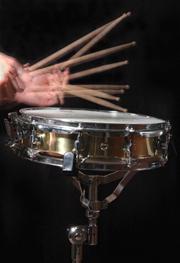Largest ever object put into quantum state.
Geoff Brumfiel
 A quantum drum has become the first visible object to be put into a superposition of quantum states.A. Olsen/iStockphoto
A quantum drum has become the first visible object to be put into a superposition of quantum states.A. Olsen/iStockphotoA team of scientists has succeeded in putting an object large enough to be visible to the naked eye into a mixed quantum state of moving and not moving.
Andrew Cleland at the University of California, Santa Barbara, and his team cooled a tiny metal paddle until it reached its quantum mechanical 'ground state' — the lowest-energy state permitted by quantum mechanics. They then used the weird rules of quantum mechanics to simultaneously set the paddle moving while leaving it standing still. The experiment shows that the principles of quantum mechanics can apply to everyday objects as well as as atomic-scale particles.
The work is simultaneously being published online today in Nature and presented today at the American Physical Society's meeting in Portland, Oregon1.
According to quantum theory, particles act as waves rather than point masses on very small scales. This has dozens of bizarre consequences: it is impossible to know a particle's exact position and velocity through space, yet it is possible for the same particle to be doing two contradictory things simultaneously. Through a phenomenon known as 'superposition' a particle can be moving and stationary at the same time — at least until an outside force acts on it. Then it instantly chooses one of the two contradictory positions.
But although the rules of quantum mechanics seem to apply at small scales, nobody has seen evidence of them on a large scale, where outside influences can more easily destroy fragile quantum states. "No one has shown to date that if you take a big object, with trillions of atoms in it, that quantum mechanics applies to its motion," Cleland says.
There is no obvious reason why the rules of quantum mechanics shouldn't apply to large objects. Erwin Schrödinger, one of the fathers of quantum mechanics, was so disturbed by the possibility of quantum weirdness on the large scale that he proposed his famous 'Schrödinger's cat' thought experiment. A cat is placed in a box with a vial of cyanide and a radioactive source. If the source decays, it triggers a device that will break the vial, killing the cat. During the time the box is shut, Schrödinger argued, the cat is in a superposition of alive and dead — an absurdity as far as he was concerned.
Wonderful weirdness
Cleland and his team took a more direct measure of quantum weirdness at the large scale. They began with a a tiny mechanical paddle, or 'quantum drum', around 30 micrometres long that vibrates when set in motion at a particular range of frequencies. Next they connected the paddle to a superconducting electrical circuit that obeyed the laws of quantum mechanics. They then cooled the system down to temperatures below one-tenth of a kelvin.
At this temperature, the paddle slipped into its quantum mechanical ground state. Using the quantum circuit, Cleland and his team verified that the paddle had no vibrational energy whatsoever. They then used the circuit to give the paddle a push and saw it wiggle at a very specific energy.
Next, the researchers put the quantum circuit into a superposition of 'push' and 'don't push', and connected it to the paddle. Through a series of careful measurements, they were able to show that the paddle was both vibrating and not vibrating simultaneously... ( more at http://www.nature.com/news/2010/100317/full/news.2010.130.html )
References
Nenhum comentário:
Postar um comentário